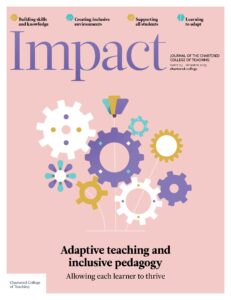Building inclusive and sustainable support for multilingual learners: A case study of Trinity Academy Leeds

JOANNA KOLOTA, CURRICULUM LEADER: MULTILINGUAL LEARNERS, TRINITY ACADEMY LEEDS, UK
Challenges in supporting multilingual learners
Supporting multilingual learners (MLs) or students who use English as an additional language (EAL) in mainstream schools is a multifaceted and often complex endeavour (DfEDepartment for Education - a ministerial department responsible for children’s services and education in England, 2020). The support encompasses academic and linguistic realms, which will be the focus in this case study, and includes social, emotional and psychological support. With more than 20 per cent of students in English state schools identified as EAL learners, and numbers steadily rising (DfE, 2023), it is important to consider whether schools and teachers are well prepared to teach in linguistically and culturally diverse classrooms.
Policy changes and their impact on EAL provision
The Teachers’ Standards in England set out expectations for teachers’ professional practice and conduct (DfE, 2011). They cover areas such as subject knowledge, classroom management, professional responsibilities and upholding high ethical and safeguarding standards. Standard 5 emphasises that all teachers share the responsibility of effectively supporting EAL learners. When teaching EAL learners, it is essential to foster an inclusive environment while recognising that English proficiency shapes their educational progress and support needs. As research shows, academic language development takes five to seven years, requiring sustained, planned and intentional linguistic support (Cummins, 1984; Strand and Lindorff, 2020). EAL students might need more tailored support, considering the second language acquisition process and the challenge of learning content and language simultaneously. However, any specific references to EAL students were removed from the 2019 OfstedThe Office for Standards in Education, Children’s Services and Skills – a non-ministerial department responsible for inspecting and regulating services that care for children and young people, and services providing education and skills framework. Similarly, other initiatives in the EAL domain have been rescinded, such as the compulsory assessment of EAL learners, the use of English proficiency scales for reporting, ring-fenced funding for EAL provision and the inclusionAn approach where a school aims to ensure that all children are educated together, with support for those who require it to access the full curriculum and contribute to and participate in all aspects of school life of an EAL inspector on the Ofsted team. With limited nationally recognised courses and degrees focused on EAL, and varying levels of importance assigned to the role of an EAL coordinator, it is crucial to consider teachers’ preparedness to support EAL students in mainstream classrooms.
Developing sustainable EAL support
A recently published article by Hammond et al. (2024) examines why some schools with linguistically and culturally diverse students achieve higher educational growth than others with similar demographics. The study focused on identifying factors contributing to the success of high-growth schools. The research highlights the importance of fostering constructive relationships between staff and students, valuing EAL expertise, enhancing teacher professional knowledge, and implementing EAL pedagogical principles systematically across the school. In essence, the main difference lies in the emphasis on language acquisition and its integration with subject matter for EAL students, as well as the extra language support, which is not necessarily prioritised in general teaching. Crucially, the study emphasises that the effectiveness of these factors depends on strong leadership that prioritises, supports and integrates them into school-wide programmes.
Trinity Academy Leeds (TAL) has focused on establishing sustainable support for EAL learners since we welcomed our first cohort of 240 students in September 2021. With 70 per cent of our students identified as MLs, a highly transient community and a significant number of mid-year starters, the academy’s focus is on genuine inclusion within mainstream lessons and the broader school community.
The role of leadership and staff development
The senior leadership team, led by the TAL principal, recognises the importance of building sustainable, long-term support for MLs. The role of curriculum leader for MLs has been integral to the school since its inception. This role reports directly to the vice principal, who oversees teaching and learning quality. Recently, additional dedicated staff members have been employed to support the school’s growing student body, which includes a rising number of students who are new to English.
This approach highlights the significance attributed to the curriculum leader’s role and their expertise. As a growing school, TAL has dedicated a substantial number of continuous professional development sessions and significant time to training in the pedagogy of EAL. In addition to in-house sessions, TAL has partnered with The Bell Foundation (an organisation that supports the educational success of EAL learners, offering training, research and practical tools for teachers to improve language outcomes), training three members of staff as Bell Foundation Licensed Practitioners. These practitioners are now equipped to deliver in-house training, using The Bell Foundation’s resources and expertise.
This expertise is continually developed among TAL staff. Each department has a Multilingual Learners Ambassador, who is allocated an additional hour in their timetable to accommodate scheduled, strategic meetings with the curriculum leader for MLs. These bi-weekly meetings establish a tiered structure of responsibility and accountability, ensuring that the curriculum remains accessible to all MLs. The meetings focus on developing tailored strategies to address the disciplinary literacy requirements of specific subjects, while considering students’ English proficiency levels (Cummins, 2021). Furthermore, insights derived from data analysis on MLs are reviewed and next steps are planned, to promote clear progression in both language acquisition and subject content mastery. We continuously refine the booklets and adjust the level of linguistic scaffoldingProgressively introducing students to new concepts to support their learning based on data analysis. For instance, if the data indicates that MLs struggle with specific academic vocabulary, we incorporate additional guided exercises, visuals or sentence stems to support comprehension. Conversely, if the data shows increased language proficiency, we gradually reduce scaffolding by encouraging independent responses. This dynamic approach allows us to tailor support to learners’ evolving needs, fostering both language development and subject mastery.
MLs’ English proficiency levels are assessed twice a year, with input from all teaching staff. This process ensures that teachers are well informed and skilled in planning for the varying levels of English language proficiency within each class. New students who join the school mid-year are assessed as part of a bespoke induction programme designed to support new starters, many of whom are attending their first school in England. Resources are meticulously planned to maintain high expectations, ensuring that content is not overly simplified or stripped down. Instead, the focus is on creating ambitious yet supportive materials that emphasise linguistic scaffolds. Last year, the MLs Toolkit was introduced to guide teachers in their planning and lesson delivery. The toolkit outlines five high-impact, evidence-based groups of strategies that are designed to provide consistent and effective support for students as they develop their language skills. The strategies include: ‘talk before writing’, which helps students to organise their thoughts verbally before putting them into writing; ‘use of first languages’, allowing students to leverage their home language for deeper understanding; ‘vocabulary development’, ensuring that students acquire and use key academic terms; ‘scaffolding’, providing structured support that is gradually removed as proficiency increases; and ‘language functions’, focusing on how students use language for different academic purposes. These strategies are further refined to ensure their applicability across all subjects, allowing teachers to practise and integrate them effectively during deliberate practice sessions.
Creating an inclusive school culture
Lastly, but critically important – as indicated by Hammond et al. (2024) – strong relationships between the school and the wider community are key to fostering an inclusive learning environment. We ensure that all families are represented and that their heritage languages and cultures are not only celebrated but also affirmed and extended. We encourage the use of first languages in learning, provide bilingual books in our library and ensure that students are reflected in the curriculum. Additionally, our annual Fusion Culture Day celebrates and affirms students’ heritage through language and cultures. In addition to preparing students for GCSE exams in heritage languages, we run initiatives such as Bilingual Book Buddies. Furthermore, we organise Family Build sessions that are specifically tailored to multilingual families. During these sessions, we facilitate dialogue about raising multilingual children, support families who are new to the area and provide language assistance.
The effectiveness of the support offered for multilingual learners at TAL has been recognised and highlighted in the most recent Ofsted report, which awarded an ‘outstanding’ verdict in all four assessed areas and highlighted the support offered to MLs. We recognise that we are still at the beginning of our journey, but we are equally excited and confident about our first cohort of students sitting GCSE examinations in 2026.
- Cummins J (1984) Bilingualism and Special Education: Issues in Assessment and Pedagogy. Clevedon: Multilingual Matters.
- Cummins J (2021) Rethinking the Education for Multilingual Learners. Bristol: Multilingual Matters.
- Department for Education (DfE) (2011) Teachers’ standards. Available at: https://assets.publishing.service.gov.uk/media/61b73d6c8fa8f50384489c9a/Teachers__Standards_Dec_2021.pdf (accessed 14 November 2024).
- Department for Education (DfE) (2020) English proficiency of pupils with English as an additional language. Available at: https://assets.publishing.service.gov.uk/media/5e55205d86650c10e8754e54/English_proficiency_of_EAL_pupils.pdf (accessed 12 November 2024).
- Department for Education (DfE) (2023) Academic year 2022/23: Schools, pupils and their characteristics. Available at: https://explore-education-statistics.service.gov.uk/find-statistics/school-pupils-and-their-characteristics/2022-23 (accessed 12 March 2025).
- Hammond J, Pennington G, Turnbull M et al. (2024) Effective practice in EAL education: Enacting distributed school leadership. Research Papers in Education. DOI: 10.1080/02671522.2024.2394034.
- Strand S and Lindorff A (2020) English as an additional language: Proficiency in English, educational achievement and rate of progression in English language learning. University of Oxford, Unbound and the Bell Foundation. Available at: www.bell-foundation.org.uk/app/uploads/2020/02/University-of-Oxford-Report-Feb-2020-web.pdf (accessed 3 March 2025).










